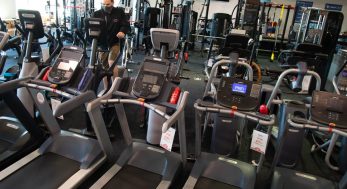
Saving & Spending
It’s easy to see gains in your wallet.
By Amy Schlinger Posted: 04/19/19 Updated: 04/22/19
This story is brought to you by Freedom Unlimited. Earn 3% cash back with your Freedom Unlimited card. Learn more.

It’s official: wellness is the new black. And health and fitness lifestyles have not only taken over your Instagram feed, but also your grocery store, pharmacy, and, yes, your bank account. Studies show Americans spend an average of $112,000 on wellness during their lifetime—that’s more than some college tuition!
There’s no denying that fitness and wellness are good for you, but does that justify spending without limits? It begs the question: how much should you actually spend on wellness?
To help, finance and fitness experts weighed in to share exactly what you should consider when investing in your wellness. But before you make a purchase, follow the tips below to get the best bang for your buck.
1. Gym membership versus boutique fitness classes
Deciding between a gym membership or boutique fitness classes? Well, the right choice depends on your fitness goals.
“If you want to get more adept in a single area of fitness, like spinning or pilates, look for the best-priced package at a studio-specific to your needs,” explains Frani Feit, CFP, managing director at Tradition Capital Management.
Boutique fitness classes can cost anywhere from $20 to $50 each, with additional fees for things like a yoga mat or shoe rentals, explains Feit.
But if you’re simply looking to break a sweat, and double down on your spending, a gym membership is your best bet.
“A general gym membership will offer a variety of workout classes, access to a personal trainer, and amenities such as a pool, sauna, and childcare,” explains consumer and money expert Andrea Woroch. “You get more value and variety than opting for a studio that focuses on one type of exercise.”
When it comes to price, a general gym membership can range anywhere from $20 per month to $200 per month, depending on the amenities and location of the facility, explains Feit. “Some have initiation fees, too,” she says.
Pro Tip: When shopping around for a gym membership, be sure to test out each amenity and try different classes. “Ultimately, you want to find a gym that meets your needs and workout preferences, so you actually use it,” Woroch says.

2. Buying a treadmill versus running outside
If you love to log miles, chances are good that you’ve thought about buying a treadmill — especially when the temperature starts to drop. But you need to keep in mind that it’s a costly purchase—one that takes up a lot of space, too. Running outside isn’t only a great workout with beautiful scenery, but it’s also free, reminds Woroch. “As long as you have the right clothing for cold weather and sweat-wicking options for summer, you’ll enjoy your run just as much outdoors,” she says.
Go ahead, use your savings to buy a great pair of sneakers.
Pro Tip: Still want to buy a treadmill or stationary bike for your home? Instead of buying brand-new equipment—which can cost hundreds, if not thousands, of dollars—scour your social media feed for listings or ask a local gym that’s undergoing renovations if they’re selling their old wares.
3. Weekly massages versus big monthly spa day
Aches and tight muscles need to be tended to, but that weekly rub down can start to wreak havoc on your bank account. While there are often membership packages you can buy that can save you a couple of bucks, Feit says they still range from $30 to $500 per visit.
“Monthly spa visits may be more financially sound depending on what you are getting done,” explains Feit. “Weekly massages will add up quickly and can garner additional costs.”
Pro Tip: Unless you’re loyal to a particular masseuse, check local websites and social media pages to find the best deals in your area.
4. Protein shakes versus a D.I.Y recipe
Post-workout when you’re famished and exhausted, it’s so easy to reach for and purchase a pre-made shake from the gym, juice bar, or corner grocer. But how much more difficult is it really to mix a scoop of protein from your tub at home with some water, and just shake it up yourself?
“A 12-pack of protein shakes costs about $22, which works out to about $1.83 per day,” explains Todd R. Christensen, education manager for MoneyFit.org by DRS. “A three-pound tub of protein with 40 servings runs around $40, which works out to be $1 per serving.” The difference: 83 cents. And if you’re thinking, “It’s only 83 cents, and it’s convenient, so I’m willing to pay the premium,” you may want to think again.
“If you figure out the difference over a year’s time, you will save about $300 by using the powder,” explains Christensen. “Is the convenience worth $300 a year to you, which is equivalent to a night at a nice hotel in most cities or 25 movie tickets?”
Pro Tip: Buy protein powder in bulk at wholesale clubs. According to Woroch, these supplements usually have a long shelf life.
Amy Schlinger is Chase contributor. Her work has been published in Women’s Health, The New York Post, and Self, among others.
Screen Reader Users: To load more articles, scroll down the page, or click the list of articles.


